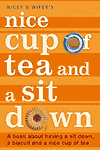Milk Chocolate and Orange Hobnob | | Friday 24 Feb 2006 |
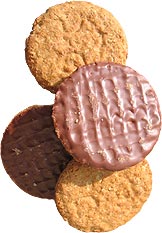 | In our recent biscuit poll the Chocolate Hobnobs both plain and milk came tops as the favourite biscuits that people are most loyal to. Or to put it another way not only do people like them but they all buy them too. With all that's been happening to the Hobnob's stablemate and elder statesman the Digestive it was only a matter of time before the Hobnob received some similar attention. Once again the Orange was choosen for the mission of coming up with a new sort of biscuit, and once again we got our hands on pack of them before they hit the shelves.
So what can we say about the HobNob that we haven't said before no doubt you are wondering as are we? Well it is worth pointing out what an amazing success story this oaty biscuit is. From a standing start in the 1980s it quickly rose to become one of the most successful biscuits ever, and it did it fairly much through simply being rather tasty. In fact so famous has the Hobnob become that even the Americans have heard of it, mostly through it being mentioned by Douglas Adams once.
So now we come to the important matter of what these chocolate orange Hobnobs actually taste like. Now when we encountered the first flavoured Digestives such as Lemon and Ginger, and subsequently the Milk Chocolate and Orange our hopes were for new vistas of biscuit taste to be revealed. We quickly learned that the flavours were much more evolutionary that revolutionary. Thus it would appear to be with this new biscuit, and gain to put it another way, they tasted just as we suspected they would, with a pleasant orangey tang emanating from the biscuit. This is no bad thing and harks back to the earliest days of the Hobnob which seemed instantly familiar. Perhaps this explains why they so successful at finding their way into the nation's biscuit tins.
So with the formalities over Wifey and I soon polished off a few with our mid morning cuppa, with the occasional approving noise to heard over the munching. This left me to search the packet to see if it actually held any surprises, given that the biscuits had been so predictable no matter how nice that had been. The best I could come up with is that the obligatory strap line "One nibble and your nobbled" had disappeared. Always one for reading deep meaning into such things perhaps McVities feel that that we are all now 'nobbled', and the vast majority of us have long since passed the one nibble stage. As such these new Milk Chocolate and Orange Hobnobs will be another big seller for McVities when they hit the shelves in March.
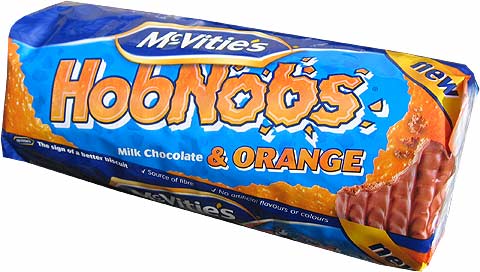
|
| Bastogne | | Wednesday 15 Feb 2006 |
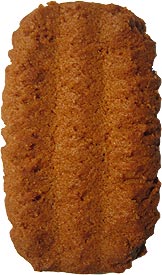 | At this time of year NCOTAASD team like to make to make two incursions on to French soil. The first a sweeping manoeuvre down from the Swiss boarder and into Haute Savoie or as the younger members of staff call it, 'the snowy France'. This is followed a week or two later by a much shorter attack, a mere few hours long, on the supermarkets of the channel ports which I tend to call 'the shopping France'. Both have their merits. The high altitude manoeuvres allow for detailed reconnoissance of French biscuit aisles, whilst the lighting quick shopping strikes allow for great numbers of biscuits to fall into our hands. This year we captured a pack of Bastogne.
Now at this point you might be about to wearily think 'not another of Nicey's protracted military metaphors again' and indeed you might be right, but Bastogne also happens to be a small town in the Ardennes region of Belgium which featured prominently in WWII. Before the history lesson what about the biscuits?
The deep brown colour may easily fool you on first glance into thinking that these were some kind of cocoa flavoured biscuit. But what we are dealing with here is French biscuit powerhouse LU's very own Spekaloo. For those of you not previously paying attention to what that means, its a classic style of biscuit flavoured by its caramelised candy sugar content an cinnamon, typical of the Benelux countries. That deep brown colour comes from the cane sugar caramelising on baking. When we reviewed the Lotus Caramelised biscuit we were in very similar territory. They are, however, quite a bit larger than typical Belgian Speckaloos. The big Bastognes are also a good bit fluffier and not nearly as compact. So despite their large size they are seen off comfortably in a couple of bites.
That open texture also manages to contribute to the appearance of the upper surface of the biscuit which has a dragged through a hedge backwards demeanour about it. I'm willing to admit that getting all your biscuits to come out looking slightly scuffed on top is probably quite technical. Alas, LU have detracted from such a marvellous technical achievement on the packing by cloning the same biscuit image to show two biscuits side by side. You might fool the French with such cut and paste trickery, but not a Brit on his second cup of tea 25 minutes into a 45 minute tea break, oh no.
And so to WWII. Bastogne was the town that was successfully held by the Americans during the Battle of the Bulge. When the surrounding German forces requested the Allies to surrender Airborne 101st's acting commander, General Anthony McAuliffe sent back the now immortal reply "Nuts!". Perhaps this goes some way to explaining why Bastogne is one of LUs successful exports to the USA.
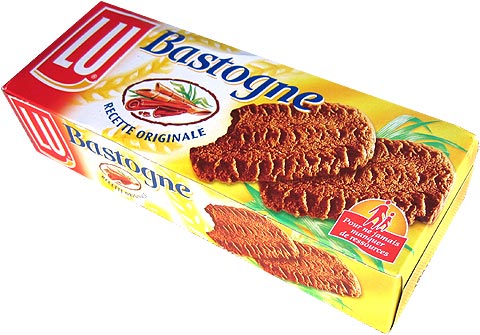
Your feedback 1 message |
| Arnott's Gingernut | | Friday 27 Jan 2006 |
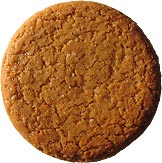 | When the Voyager space craft flew by Saturn in the early 1980s the space scientists gazed upon the images sent back of its icy little moons with names like Mimas, Enceladus, Tethys, Dione and Rhea. It was the first time any of these little worlds had been anything more than tiny specks of light to human eyes. The scientists eagerly studied the cracks and fissures in the surfaces of these frozen little worlds trying to piece together their history and composition. I get a similar buzz looking at new Gingernuts.
So thanks to Alison Anderson who has sent us one of the four sub species of Arnotts Gingernut, brought over from Australia when she visited the UK over Christmas. A quick recap for those not familiar with the Arnotts Ginger Nut story. Australian biscuit legend Arnotts used to bake ginger nuts in four regional bakeries across the country, each had its own unique characteristics. When Arnotts tried a unified pan-Austrailan Ginger which according to Alison was based on the super hard New South Wales ginger nut sales dropped away. So Arnotts relented and now bake four different types of ginger nut, in the same bakery for the different states, but all in the same packaging. Oh how we would love to test this out, but at least we are now 25% nearer to a complete understanding. Being from NSW Alison has supplied a pack of her local biscuits.
At only 52mm diameter and 8mm thick this is already a compact little biscuit. Returning to those cracks and fissures I'm put in mind of another southern hemisphere Gingernut the Griffins from New Zealand. Again we see an even distribution of cracks which indicates this ginger nut raised itself in a quite a uniform and even way. The otherwise hard shiny exterior and the shallowness of the fissures tells us to prepare for a hard biscuit.
Well I didn't prepare myself fully because these little chaps are almost off the scale, if there was a scale for them to be on. My canine teeth left small pin head sized dents in the surface, with traces of whitish impacted Ginger dust in them. The illusion of tackling a small sheet of granite with a chisel was completed when I did on the third attempt manage to split on in two. The cleaved surfaces were free from crumbs and almost glassy in finish.
I had a simple choice back off and try and preserve my dental health or wade into them. I bravely took the second option, as I hadn't yet really started to think about how they tasted. They tasted fine, only mildly gingery and a pleasant uncomplicated sweetness devoid of fancy recourse to molasses or some other dark syrup. By the third or fourth I had made up my mind that I definitely liked these a lot.
When last week I exchanged emails with Paul from Victoria about the subject of Arnotts Tartlets, I told him I had never had them so no matter how wonderful he thought they were I couldn't declare them the finest tartlets on the planet. I think I went to explain that Tartlets may presently be confined as a biscuit phenomena to Australia itself, but to cheer up as I had some Arnotts Gingernuts. He said that Gingernuts were a biscuit for his Grandmother. Well good luck to her, she must have a brilliant set of nashers for an old dear, but as Arnotts themselves say "In Victoria and Tasmania, they are bigger, softer and sweeter". We have yet to confirm that.
Your feedback 1 message |
| |
|
|
